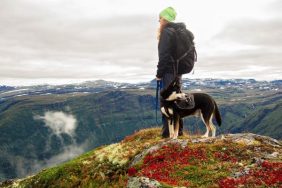 There can be no better bonding experience between a human and a dog than hiking together in the wild outdoors on long nature trails. And considering that the human will be the one setting the pace, a dog has to keep up with its companion. A good physical fitness plan needs to be implemented; as well as, other training needs to also be accomplished before a successful long-distance hike can ever have a chance to reach its potential.
There can be no better bonding experience between a human and a dog than hiking together in the wild outdoors on long nature trails. And considering that the human will be the one setting the pace, a dog has to keep up with its companion. A good physical fitness plan needs to be implemented; as well as, other training needs to also be accomplished before a successful long-distance hike can ever have a chance to reach its potential.
Before a dog can ever be ready for any physical training, its human companion should make sure the dog is healthy and protected. A veterinarian can handle the health determination but a good flea and tick collar will keep any dog protected from pesky pests. A good collar like the Bayer Seresto is a high quality prevention tool and will not only repel fleas and ticks, but it will also kill fleas and ticks.
It’s all about the feet. To start a dog’s training, you should try to use a well groomed trail or a non-rocky field. This will give your dog a good workout without his or her feet getting blown out with blisters and cuts. It would really benefit any canine to get used to wearing protective booties for short amounts of time. Sometimes nature can throw some nasty obstacles in our way and booties can protect a dog from most items that can afflict the feet.
Not only does physical fitness help a hike register on the fun meter, but it prevents injuries and exhaustion. There is no substitute for miles. You have to walk miles to walk more miles and this means building up to an adequate distance and learning your dog’s limits. Starting off with shorter 5-7 mile hikes are good starting point. It’s no secret that dogs will outdo themselves if they love what they’re doing so don’t give them that chance and monitor them for their own safety. After a couple sets of these shorter hikes, it’s time to start building up.
Nutrition is a big deal for humans, but it is just as important for dogs. Most long-distance hikers either carry healthy freeze-dried dog food themselves or they have their dogs carry the food in dog packs. Either way, there is a huge selection of freeze-dried foods available in both pucks and logs. To make the most of freeze-dried foods and to not introduce something too new, a dog should occasionally be fed freeze-dried foods before a long hike to get him or her acclimated to the new grub. The goal is to have light-weight food that tastes good and has a lot of nutrition.
Finally, leash training is very important for not only practicing good manners and being legal where appropriate, but it is also a safety issue. Sometimes a dog needs to be leashed for the owner and dog to avoid harmful situations like wild animals, dangerous terrain or to avoid other dogs. Also, every state and national park has their own leash rules. Although it might seem like you are taking away some of a dog’s freedoms with a leash, you would actually be doing it for their own good and to possibly follow local and federal laws.
Enjoying long hikes with a four-legged friend can be epic, but only if a dog is ready for it in both mind and body. That’s up to the human.








